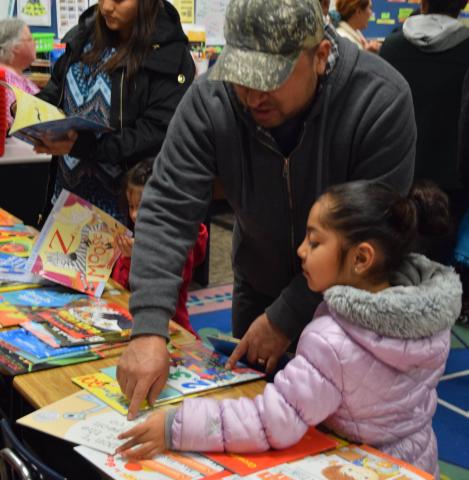Developing a Readerly Identity with Young Children // Part 2 of 2
 As Children's Authors and Illustrators Week 2019 continues, Dr. Mike Macaluso shares Part 2 of his post on how to encourage a reader identity in young children. In Part 1, Dr. Mac told the story of how he had difficulty seeing himself as a reader in his early years of school. Dr. Mac's parents capitalized on his love for comic books to help him see that (1) reading could be enjoyable and (2) that he was a capable reader. Now that he is an English education professor with four children of his own, he offers parents and teachers two more tips for inspiring a love of reading in their young children.
As Children's Authors and Illustrators Week 2019 continues, Dr. Mike Macaluso shares Part 2 of his post on how to encourage a reader identity in young children. In Part 1, Dr. Mac told the story of how he had difficulty seeing himself as a reader in his early years of school. Dr. Mac's parents capitalized on his love for comic books to help him see that (1) reading could be enjoyable and (2) that he was a capable reader. Now that he is an English education professor with four children of his own, he offers parents and teachers two more tips for inspiring a love of reading in their young children.

Tip 2: Set Aside Time!
Children need established, dedicated time to be able to read those choices– whether in the classroom or in the home. Providing this dedicated time is crucial if we expect them to be lifelong readers. If their only experience of reading at home is with books for school, where they know they will be tested, it's not enough. The carrot at the end of the stick cannot be evaluated. The carrot needs to be another book!

Plan time during the school day or at home that is dedicated to reading. Parents and teachers may even "track" kids' reading progress by checking off books they've read from a list, by creating separate piles of "read" and "to read" books, or by creating a bulletin board where students can write down and tack up titles of books they've read. In each of these cases, kids can see the progress they are making and will feel accomplished! Parents and teachers can often encourage excitement around this reading time by dedicating time to some "structured support" around the topic of the book. For example, if a student is reading about dolphins, an adult may find a short YouTube clip about dolphins. If a young reader likes mysteries, then they may play Clue or Clue Jr. to hone their detective skills. The Magic Tree House series brilliantly began publishing nonfiction "research guides" to supplement kids' reading of these engaging stories. For example, don't know much about Egypt or wish you knew more about how Mummies are made while reading Mummies in the Morning? Then check out Jack and Annie's Research Guide to Mummies and Pyramids. Perusing this book is a great way for parents and teachers to support independent reading time.

Tip 3: Talk about books!
It's important to have authentic conversations with kids about the books they are reading–all readers need and want to talk about books, even adults! More often than not, conversations about books help readers to better understand those books and can lead readers to their next one. So, take the time to talk and ask them: What's interesting about the book? What did you learn? Which characters do you like best and why? Reading quizzes, skill-and-strategy-based teaching, even graphic organizers (admittedly, a go-to tool of mine) can sometimes interrupt the reading process... so can bedtime, variable schedules and after-school activities, and life! Conversations help to bridge those times.
In addition to talking about the books your children or students are currently reading, take some time to casually discuss books in general, books you are currently reading, some interesting facts you just read about, or a new book you're hoping to read. Conversation about books and reading creates an environment and expectation that norms literacy.
It's easy to blame social media, Netflix binging, or video games for our reading woes, but really, small steps could lead to big gains when it comes to the reading lives of our children, and I recognize now the great privilege I had in parents who could and would support my reading habits. If we want our kids to be lifelong readers, then they need to feel good about reading–they must find joy in what and how they read, and they must feel comfortable, confident, and competent in picking up any book. Giving young readers structured support in selecting "the right"books, making time for them to actually read those books, and talking with them about those books and their reading might help shift their reading habits from feeling like a chore or strategy to something that arouses joy, discovery, and conversation. It sounds simple, and it is.
If you're interested in learning more about how to develop readerly identities in your children or students, you might consider checking out some of these great resources:
- Reading Reconsidered by Doug Lemov (of Teach Like a Champion fame)
- The Book in Question: Why and How Reading Is In Crisis (2019) by Carol Jago
- Literacy Leadership Brief: Creating Passionate Readers Through Independent Reading (2019) by the International Literacy Association
- Struggle Is Not a Bad Word: Misconceptions and Recommendations About Readers Struggling With Difficult Texts (2019) by Lupo et al. in the Journal of Adolescent and Adult Literacy
Happy Reading,

